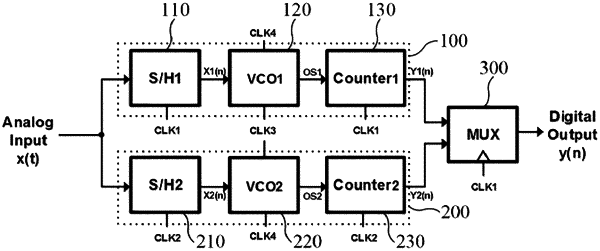| CPC H03M 1/1215 (2013.01) [H03M 1/1245 (2013.01)] | 18 Claims |

|
1. A band-pass analog-to-digital converter (ADC) using a bidirectional voltage-controlled oscillator (VCO), the ADC comprising:
a first converter configured to receive an analog input signal and quantize the analog input signal according to a first clock signal to output a first digital signal;
a second converter configured to receive the analog input signal and quantize the analog input signal in a time-interleaving manner according to a second clock signal, which has a phase opposite to that of the first clock signal, to output a second digital signal; and
a multiplexer configured to receive the first and second digital signals and select one of the two signals in response to the first clock signal to finally output a digital output signal,
wherein the first converter comprising:
a first sampling/holding part configured to sample a voltage level of the analog input signal at a rising edge of the first clock signal and hold the voltage level of the analog input signal until a next rising edge of the first clock signal to output a first sampling signal;
a first VCO configured to output a first oscillation signal having a frequency proportional to a voltage level of the first sampling signal in response to a third clock signal and a fourth clock signal each having a frequency of half of a frequency of the first clock signal; and
a first counter configured to count the number of pulse signals in the first oscillation signal to output the first digital signal.
|